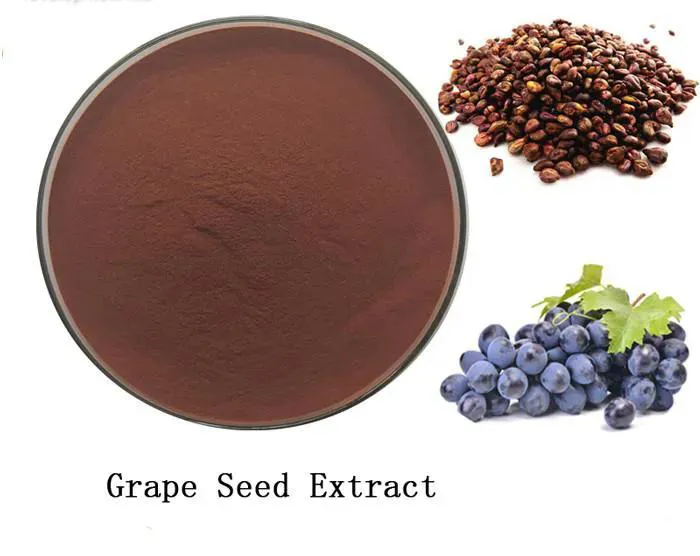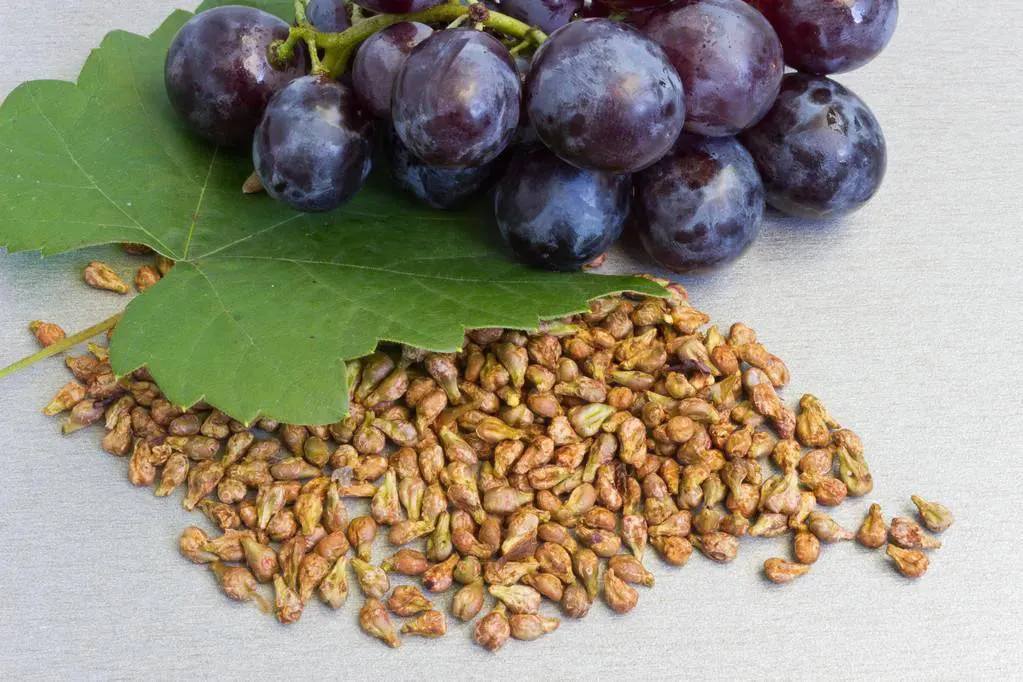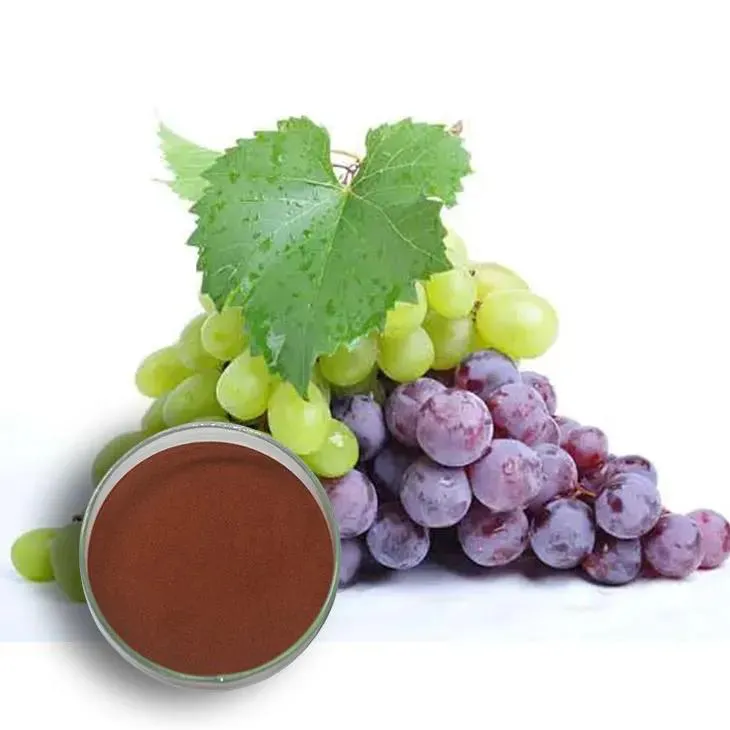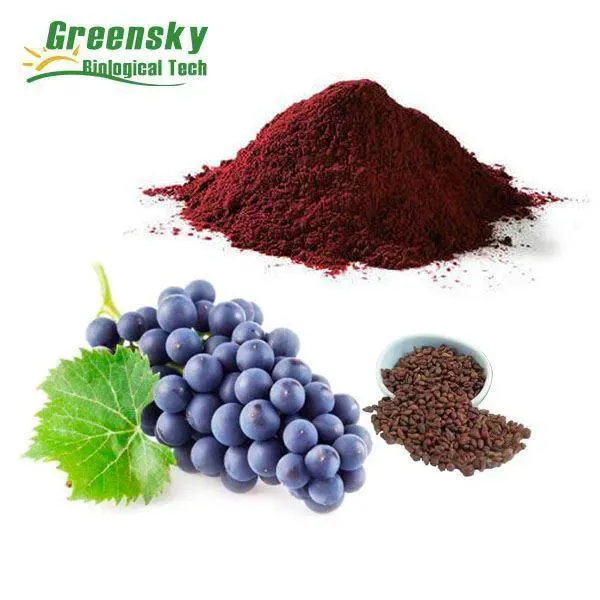- 0086-571-85302990
- sales@greenskybio.com
Grape Seed Extract: A Journey from Harvest to Health
2024-08-17

1. Introduction
Grape Seed Extract has emerged as a remarkable natural product with a wide range of potential health benefits. Its journey from the vineyard to the consumer's health regimen is a complex and fascinating one. This article will explore in detail the various stages of this journey, starting from the harvesting of grapes all the way to its role in promoting human health.

2. The Harvest of Grapes: The Starting Point
2.1 Selecting the Right Time
The process of obtaining high - quality Grape Seed Extract begins with the harvest of grapes. Timing is crucial. Grapes need to be harvested at the optimal stage of ripeness. If they are picked too early, they may not have developed all the necessary compounds. On the other hand, if they are left on the vine for too long, they may start to decay or lose some of their beneficial properties. Growers typically use a combination of visual inspection, taste, and analytical methods to determine the best time for harvest. For example, they look at the color of the grapes, the firmness of the berries, and the sugar content. In many wine - producing regions, grapes are harvested when they reach a specific sugar - to - acid ratio, which is also important for the production of Grape Seed Extract as it can influence the composition of the seeds.
2.2 Harvesting Methods
There are different methods of harvesting grapes. One common method is manual harvesting. This is often preferred for high - quality grapes used in premium wine production and, by extension, for grape seed extract production. Manual harvesters carefully pick the grape bunches, ensuring that only ripe and healthy grapes are selected. This method is more labor - intensive but can result in a more consistent quality of grapes. Another method is mechanical harvesting. This is more efficient in terms of time and cost, especially for large - scale vineyards. However, mechanical harvesters may not be as selective as human harvesters, and there is a risk of including unripe or damaged grapes. Nevertheless, with proper calibration and management, mechanical harvesting can also be used to obtain grapes suitable for grape seed extract production.

3. Processing the Grapes: Towards the Seeds
3.1 Sorting and Cleaning
Once the grapes are harvested, they are taken to the processing facility. The first step here is sorting and cleaning. The grapes are sorted to remove any unripe, damaged, or diseased berries. This can be done manually or using mechanical sorting devices. After sorting, the grapes are thoroughly cleaned to remove dirt, debris, and any pesticide residues. This is an important step as contaminants can affect the quality of the final grape seed extract. Cleaned grapes are then ready for the next stage of processing.
3.2 Separating the Seeds
The next step is to separate the seeds from the grape pulp. There are several methods for this. One common approach is crushing the grapes to release the juice and the seeds. The crushed grapes are then passed through a press to separate the juice from the solid components, including the seeds. Another method involves enzymatic treatment of the grapes, which helps to break down the pulp and release the seeds more easily. Once the seeds are separated, they are collected and further processed.

4. Extraction: Unlocking the Beneficial Compounds
4.1 Types of Extraction Methods
There are different extraction methods used to obtain grape seed extract. Solvent extraction is one of the most common methods. In this method, a suitable solvent, such as ethanol or methanol, is used to dissolve the beneficial compounds from the grape seeds. The solvent is then evaporated, leaving behind the concentrated extract. Another method is supercritical fluid extraction. This uses a supercritical fluid, typically carbon dioxide, which has properties between a liquid and a gas. Supercritical fluid extraction has the advantage of being a more "green" method as it does not leave behind solvent residues, and it can be more selective in extracting specific compounds. Additionally, there is aqueous extraction, which uses water as the solvent. This method is considered more natural but may not be as efficient in extracting all the desired compounds as the other methods.
4.2 Factors Affecting Extraction
Several factors can affect the extraction process. The choice of extraction method, as mentioned above, is a significant factor. The temperature, pressure, and time of extraction also play important roles. For example, in solvent extraction, higher temperatures may increase the solubility of the compounds but may also lead to the degradation of some heat - sensitive components. Similarly, in supercritical fluid extraction, the pressure needs to be carefully controlled to ensure optimal extraction. The duration of extraction also needs to be optimized to obtain a high - quality extract with a maximum concentration of beneficial compounds.

5. Composition of Grape Seed Extract: The Key Components
5.1 Proanthocyanidins
One of the most important components of grape seed extract is proanthocyanidins. These are a class of flavonoids that are known for their antioxidant properties. Proanthocyanidins can scavenge free radicals in the body, which are unstable molecules that can cause damage to cells and contribute to various diseases such as cancer, heart disease, and aging. They also have anti - inflammatory effects, which can help reduce inflammation in the body and improve overall health. Proanthocyanidins in grape seed extract are present in different oligomeric and polymeric forms, and their composition can vary depending on the grape variety and extraction method.
5.2 Resveratrol
Another notable component is resveratrol. Resveratrol is a polyphenol that has received a great deal of attention in recent years for its potential health benefits. It has been shown to have antioxidant, anti - inflammatory, and anti - cancer properties. In grape seed extract, resveratrol is present in relatively small amounts compared to proanthocyanidins, but it still contributes to the overall health - promoting effects of the extract. Resveratrol is also found in grape skins, and its presence in grape seed extract may be related to the extraction process and the interaction between the seeds and skins during processing.
5.3 Other Compounds
Grape seed extract also contains other compounds such as flavonols, anthocyanins (although in smaller amounts compared to what is found in grape skins), and various minerals and vitamins. Flavonols contribute to the antioxidant activity of the extract, while anthocyanins are known for their role in protecting against oxidative stress. The presence of minerals like potassium and magnesium, and vitamins such as vitamin E in grape seed extract also adds to its nutritional value.
6. Health Benefits of Grape Seed Extract
6.1 Antioxidant Activity
The antioxidant activity of grape seed extract is one of its most well - known health benefits. As mentioned earlier, the proanthocyanidins and other flavonoids in the extract can neutralize free radicals in the body. This helps to protect cells from oxidative damage, which is associated with a wide range of diseases including neurodegenerative diseases like Alzheimer's and Parkinson's, as well as cardiovascular diseases. By reducing oxidative stress, grape seed extract may also help to slow down the aging process.
6.2 Cardiovascular Health
Grape seed extract has been shown to have positive effects on cardiovascular health. It can help to lower blood pressure by relaxing blood vessels. This is due in part to its antioxidant and anti - inflammatory properties. Additionally, it may help to reduce LDL (bad) cholesterol levels and increase HDL (good) cholesterol levels. It can also prevent the formation of blood clots, which are a major risk factor for heart attacks and strokes. Some studies have suggested that regular consumption of grape seed extract may improve overall heart function and reduce the risk of cardiovascular diseases.
6.3 Anti - Inflammatory Effects
The anti - inflammatory properties of grape seed extract are another important aspect of its health benefits. Inflammation is a natural response of the body to injury or infection, but chronic inflammation can lead to various diseases such as arthritis, diabetes, and certain cancers. Grape seed extract can help to reduce inflammation by inhibiting the production of inflammatory mediators in the body. This can lead to a reduction in pain and swelling in conditions such as rheumatoid arthritis and may also help to prevent the development of chronic inflammatory diseases.
6.4 Skin Health
For skin health, grape seed extract can be beneficial in several ways. Its antioxidant activity helps to protect the skin from damage caused by UV radiation and environmental pollutants. It can also improve skin elasticity and firmness by promoting collagen production. Collagen is a protein that is essential for maintaining the structure and elasticity of the skin. Additionally, grape seed extract may have anti - acne properties as it can help to reduce inflammation in the skin and kill bacteria that are associated with acne formation.
6.5 Other Potential Benefits
There are also other potential health benefits of grape seed extract. Some research has suggested that it may have a role in improving cognitive function, perhaps by reducing oxidative stress in the brain. It may also help to improve digestive health by reducing inflammation in the gut and promoting the growth of beneficial gut bacteria. Moreover, grape seed extract has been investigated for its potential anti - cancer properties, although more research is needed in this area to fully understand its role in cancer prevention and treatment.
7. Safety and Precautions
While grape seed extract is generally considered safe for most people when taken in appropriate doses, there are some precautions to be aware of. Some individuals may experience mild side effects such as nausea, stomach upset, or allergic reactions. People who are allergic to grapes or grape products should avoid grape seed extract. Additionally, since grape seed extract may have blood - thinning effects, it should be used with caution by people taking blood - thinning medications such as warfarin. Pregnant and breastfeeding women should also consult their healthcare providers before taking grape seed extract as there is limited research on its safety in these populations.
8. Conclusion
The journey of grape seed extract from harvest to health is a remarkable one. Starting from the careful harvesting of grapes, through the complex processing and extraction steps, to the final product with its numerous health - promoting properties. Grape seed extract offers a natural and potentially powerful way to support overall health. However, more research is still needed to fully understand its mechanisms of action and to explore its potential applications in different areas of health. As consumers become more interested in natural health products, grape seed extract is likely to continue to gain popularity as a valuable addition to a healthy lifestyle.
FAQ:
What are the main steps in the process from grape harvest to obtaining grape seed extract?
The process starts with harvesting ripe grapes. After that, sophisticated extraction techniques are employed to retrieve the beneficial substances from the grape seeds, which ultimately results in grape seed extract.
How does grape seed extract fight free radicals?
Grape seed extract contains certain compounds, such as polyphenols, which have antioxidant properties. These antioxidants can neutralize free radicals by donating an electron to them, thus preventing the free radicals from causing damage to cells and tissues.
What are the overall health benefits of grape seed extract?
Grape seed extract is known to support overall well - being. Besides fighting free radicals, it may also have anti - inflammatory effects, improve cardiovascular health, and potentially contribute to skin health by protecting against oxidative stress.
What kind of extraction techniques are used to obtain grape seed extract?
Common extraction techniques include solvent extraction, where solvents are used to dissolve and separate the active components from the grape seeds. Another method could be supercritical fluid extraction, which uses supercritical fluids under specific pressure and temperature conditions to extract the beneficial substances.
Are there any side effects associated with grape seed extract?
In general, when taken in moderation, grape seed extract is considered safe for most people. However, some individuals may experience mild side effects such as headache, itchy scalp, or dizziness. It is always advisable to consult a healthcare professional before starting any new supplement.
Related literature
- The Health Benefits of Grape Seed Extract: A Review"
- "Grape Seed Extract: From Grape to Medicine"
- "Harvesting and Extracting Grape Seed for Health - Promoting Compounds"
- ▶ Hesperidin
- ▶ citrus bioflavonoids
- ▶ plant extract
- ▶ lycopene
- ▶ Diosmin
- ▶ Grape seed extract
- ▶ Sea buckthorn Juice Powder
- ▶ Beetroot powder
- ▶ Hops Extract
- ▶ Artichoke Extract
- ▶ Reishi mushroom extract
- ▶ Astaxanthin
- ▶ Green Tea Extract
- ▶ Curcumin Extract
- ▶ Horse Chestnut Extract
- ▶ Other Problems
- ▶ Boswellia Serrata Extract
- ▶ Resveratrol Extract
- ▶ Marigold Extract
- ▶ Grape Leaf Extract
- ▶ blog3
-
Carrageenan Extract Powder
2024-08-17
-
Hericium erinaceus extract powder
2024-08-17
-
Camu Camu Extract
2024-08-17
-
Jujube Extract
2024-08-17
-
Longan Extract
2024-08-17
-
Reishi mushroom extract
2024-08-17
-
Citrus Aurantii Extract
2024-08-17
-
Cranberry Extract
2024-08-17
-
Natural grape seed extract
2024-08-17
-
Beta Carotene
2024-08-17





















